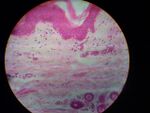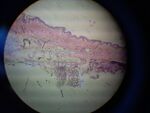Axilla /histology slide
< Axilla
Skin in the axilla consists classically of the epidermis and the dermis , which contains sebaceous glands. The hypodermis (subcutaneous tissue) contains the typical apocrine glands.
Layers[edit | edit source]
Epidermis[edit | edit source]
The epidermis (skin) consists of stratified squamous epithelium with cornification . It regularly runs into the dermis layer and thus creates epidermal ridges . On the cross-section, we distinguish five layers: str. basale , str. spinosum , str. granulosum , str. lucidum and str. corneum (for a more detailed description, see the article thick skin).
Dermis[edit | edit source]
The dermis develops from mesenchyme and consists of ligaments, that strengthen the epidermis. In some places, it runs into the epidermis and thus creates dermal papillae. It contains sebaceous glands. It consists of two layers: str. papillare and str. reticulare (for a more detailed description, see the article thick skin).
Hypodermis[edit | edit source]
The hypodermis (subcutaneous tissue) consists of thin tissue, apocrine sweat glands (eccrine – simple twisted tubular glands opening onto the surface of the skin, basally they are surrounded by myoepithelial cells).
Glands[edit | edit source]
Apocrine glands[edit | edit source]
Located in the subcutaneous tissue, the apocrine glands produce an aromatic secretion. They are 3-5 mm in size (diameter), lined by a single-layer cubic epithelium . They look "empty", they open into hair follicles (cells secrete their apical parts together with the secretion). On the surface of the skin, [bacteria]] break down the secretion, which creates a characteristic odor.
Sebaceous glands[edit | edit source]
It is located in the reticular layer in dermis. They are formed by acini attached to the hair follicle. The secretory elements of the acini stain weakly, after time they crack - sebum is produced . Acini are surrounded by epithelial cells, which are flattened at the base - basal cells . The function of these glands begins at puberty .
Ecrine glands[edit | edit source]
Simple coiled tubular glands with ducts opening to the surface of the skin. It is located in the dermis (in the upper part).
Links[edit | edit source]
Realated articles[edit | edit source]
Bibliography[edit | edit source]
- MUDR. EIS, Václav – MUDR. JELÍNEK, Štěpán – MUDR. ŠPAČEK, Martin. Histopatologický atlas [online]. ©2006. [cit. 15.04.2010]. <http://histologie.lf3.cuni.cz/histologie/atlas/index.htm>.
- JUNQUIERA, L. Carlos – CARNEIRO, José – KELLEY, Robert O.. Základy histologie. 1. edition. Jinočany : H & H 1997, 1997. 502 pp. ISBN 80-85787-37-7.


